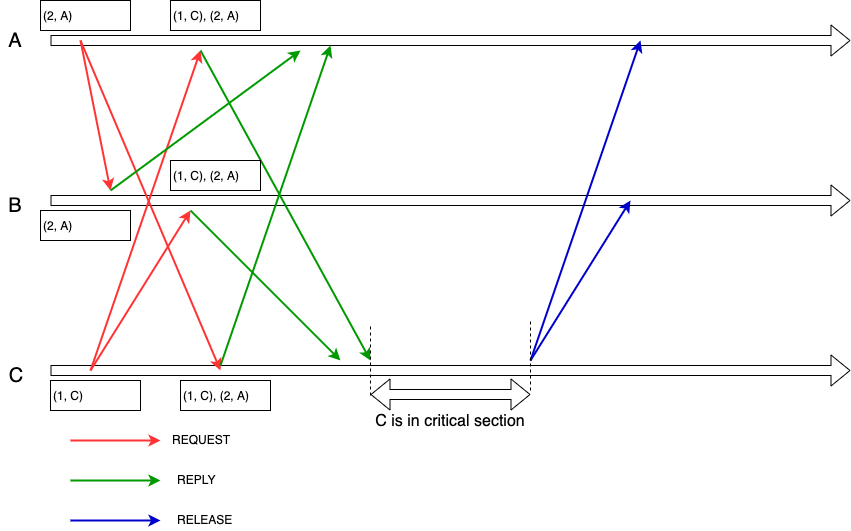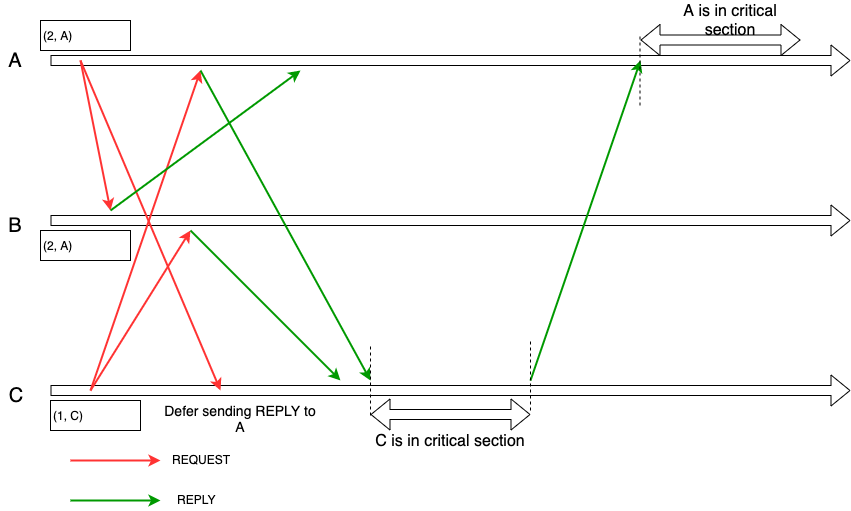The network topology contains two parts:
- Client-side server: directly interacts with inbound request. All client-side servers are inter-connected with each other.
- Backend server: interacts with client-side server, not seen by the inbound request.
- A request arrives at any client-side server.
- Client-side server sends out REQUEST message to other client-side servers.
- Client-side server receives REPLY from other client-side servers. An agreement reached regarding which client-side server enters into critical section to interact with files stored in backend servers.
- Client-side server sends WRITE or READ request to backend servers.
- After receiving responses from all backend servers, client-side server will send RELEASE.
For each client-side server, I separated inbound and outbound message handling. Each connection from other client-side servers have their own threads to handle inbound and outbound message. The purpose of this design is to increase the throughput and decouple the code.
Also, each file has a distributed mutual exclusion algorithm object to ensure only one client can successfully WRITE or READ.
- Supporting three types of operations:
WRITE: write to all replicas in backend servers.READ: read from one of the replicas in backend servers.ENQUIRY: A request from a client for information about the list of hosted files.
- Each client-side server only handle one request at a time.
- Assume that each file is replicated on all the servers, and all replicas of a file are consistent in the beginning.
- Assume that the set of file does not change during the program’s execution. Also, assume that no server failure occurs during the execution of the program.
- REQUEST from client-side server
i:- Sends REQUEST(timestamp, i) to all other client-side servers.
- Adds REQUEST(timestamp, i) to its request queue sorted by timestamp(I used PriorityQueue in implementation).
- Enters into critical section on receiving messages(not only reply message) from all other client-side servers, and find its REQUEST at the top of its request queue.
- REPLY from client-side server
jtoi:- Sends timestamped REPLY to client-side server
i. - Adds REQUEST(timestamp, i) to it request queue sorted by timestamp.
- Sends timestamped REPLY to client-side server
- RELEASE from client-side server
itoj:- Sends timestamped RELEASE to all other client-side servers and removes its request from request queue.
- Client-side server
jreceives RELEASE message, then removesi's request fromj's request queue.
- Number of messages: 3x(N - 1).
- Synchronization delay: one message propagation delay.
- Optimization: Client-side server
jcan suppress a REPLY toiifjhas already sent a request toiwith a higher timestamp.
- REQUEST from client-side server
i:- Sends REQUEST(timestamp, i) to all other client-side servers.
- Enters into critical section on receiving all REPLY from other client-side servers. And
ican hold the permission fromjuntilisends a REPLY toj. This meansidoesn't need to send request to ask permission fromjduring this time period.
- REPLY from client-side server
jtoi:- Sends timestamped REPLY to
iif either of the following conditions satisfies:jis neither requesting nor executing its critical section.j's request has ahighertimestamp(lower priority).
- Otherwise,
jdefers sending REPLY.
- Sends timestamped REPLY to
- RELEASE from client-side server
i:- Sends all deferred replies, since it will hold some lower priority request's REPLY.
- Number of messages: less than 2x(N - 1) for the optimization version.
- Synchronization delay: one message propagation delay.
iTerm2: a terminal tool similar to Mac's default terminal. It can split the window horizontally and vertically, which is a perfect choice for experimenting with distributed system.Java version 1.8
git clonemy repository.cdintoDistributedSystemAlgodirectory.- Run script:
./here_we_go.sh lamport: run Lamport mutual exclusion algorithm../here_we_go.sh ra_with_optimization: run Ricart-Agrawala algorithm with optimization proposed by Carvalho-Roucairol.
I tested 10,000 requests per client-side server(total 50,000 requests) and checked all replicas to see whether the files were identical. I didn't do a correctness verification because that's not what I am capable of till now.



